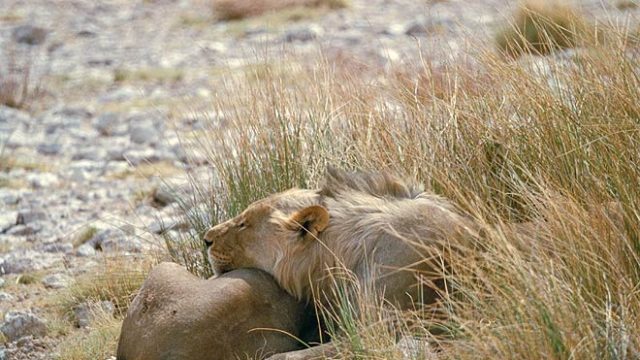The perfect introduction: KRUGER NATIONAL PARK
If you’ve never been on safari before, this is the place to start. Located northeast of both Pretoria and Johannesburg, it is South Africa’s largest park, extending 350km from Crocodile River to the Zimbabwe border, and contains its most varied wildlife. South Africa also has the best infrastructure and tourist facilities on the continent, making Kruger the obvious choice. (One camp even has its own airport!) At Kruger you can be fairly certain of spotting all the Big Five—lion, elephant, rhino, buffalo and leopard. Most exciting of all are the night rides, which offer your finest opportunity to see leopards. Kruger’s large enough for you to have exactly the experience you want—luxurious and private, or rough and basic. See www.krugerpark.co.za

Wildebeest migration: SERENGETI & MASAI MARA PARKS
For sheer spectacle few things can match the wildebeest migrationfrom the Serengeti National Park to the Masai Mara from July toOctober, a round trip of some 2,900km. Close to two million of thegiant beasts make the hazardous journey north. Lions, cheetahs andleopards follow along, as do scavenging hyenas and jackals, anticipatingeasy pickings, and crocodiles too are a major worry as panickedwildebeest negotiate the Mara. The Serengeti region includes Kenya’sMasai Mara Game Reserve. While far fewer visit the Serengeti thanKruger, the former is more iconic and offers a more authentic experience.For a bird’s eye view of the game and an experience you’ll neverforget splash out on a hot air balloon ride across the Serengeti; try alsoan elephant-back safari. See www.serengeti.org
Gorilla tracking: BWINDI IMPENETRABLE NATIONAL PARK
This park in Uganda is ancient, a rainforest that survived through thelast ice age and is home now to half the world’s mountain gorilla population.The gorillas, of course, are the primary reason to visit the BwindiImpenetrable National Park but, as you’ll discover when you visit, notthe only reason. Located along the border with the Democratic Republicof Congo, a six- to eight-hour drive from Kampala, the Ugandan capital,Bwindi offers wonderful birding, majestic scenery and 120 species ofmammals. Be warned though, you’ll have to hike some tough trails tocatch sight of the elusive gorillas and you’ll have to get a permit fromthe Uganda Wildlife Authority. Only 18 visitors are allowed per day ingroups of six. Gorillas are incredibly sensitive and even catching somethingas innocuous as a cold could kill one. See www.uwa.or.ug

Through the Okavango Delta on a canoe: BOTSWANA
Botswana is often overshadowed by its hulking neighbour, SouthAfrica. But for the discerning tourist Botswana offers plenty of rewards. Ithas more elephants per square mile than any other African country, andits lions are famously virile. There’s also a better-than-ordinary chance ofspotting a cheetah. The beautiful Okavango Delta is a maze of lagoons,lakes and waterways spanning 17,000 square kilometres, making it justabout the largest inland delta in the world. You will be transportedthrough the delta in a mokoro, a dug-out canoe poled through the watersby a guide. The best time for viewing game is May to October;November to April is best for birding. See www.okavango-delta.net
Search for the rare black Rhino: ETOSHA SALT PAN
Another of South Africa’s glittering neighbours, Namibia gained full political independence in 1990. As more travellers choose to veer off the tourist trail, destinations like Namibia’s Etosha National Park, 500km north of the capital Windhoek, will become increasingly popular. So visit now while the crowds are still relatively sparse. Etosha’s standout feature is the massive salt pan, originally a lake fed by a river until, thousands of years ago, the river changed course. Dried up now, the pan glints a dazzling white under the African sun. As the light changes through the day, the pan glows orange, pink and even blue. Etosha contains one of Africa’s largest populations of black rhino, a rare and endangered species. See www.namibian.org/travel/namibia/etosha

Walk on the wild side: LUANGWA NATIONAL PARK
Zambia is a destination celebrated by wildlife purists for its expanses of lush vegetation, the quality of wildlife spotting and the famous ‘walking safaris’. It is also a country ravaged by poverty. Only three of Zambia’s 19 parks make any money and the inability to control poaching has led to the country’s rhino population being wiped out. The South Luangwa National Park is the gorgeous Luangwa Valley’s most accessible and popular park. There is a huge hippopotamus population, estimated to be about 50 per kilometre of the Luangwa River, and then there’s Thornicraft’s Giraffe, unique to the valley, and large populations of leopard, crocodile and the beautiful kudu antelope. Across the river is the comparatively deserted North Luangwa National Park, where you can walk in the wild entirely undisturbed. See www.zambiatourism.com




